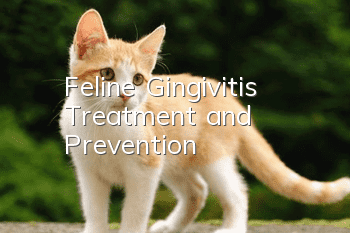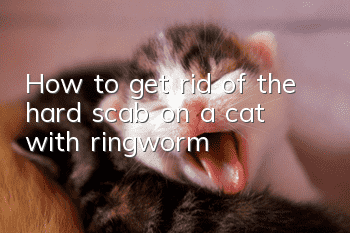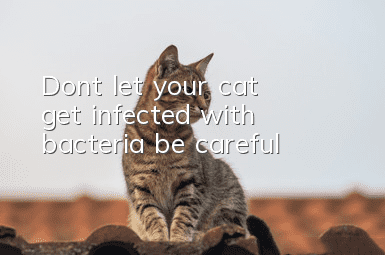Feline Gingivitis: Treatment and Prevention

Gingivitis is inflammation of the gum tissue, mainly caused by bacteria, plaque, and calculus (tartar).
The order of formation of the above three culprits is: bacteria cause plaque, and plaque causes the gradual accumulation of dental calculus. The bacteria that form dental plaque usually live on the surface of the food that cats eat, especially dry food that has not been sealed and stored. These bacteria will form an invisible film on the surface of the teeth.
Plaque is very stubborn and will appear again within a few minutes even after cleaning.
The formation of dental calculus depends on the combination of minerals in the cat's saliva with dental plaque or bacteria. The dental calculus formed is yellow and hard, and adheres firmly to the teeth.
Dental calculus can further irritate the gums and lead to gingivitis.
When plaque begins to build up on the tooth surface, calculus will be most obvious along the gum line.
01. Early and late symptoms of gingivitis
Gingivitis usually develops slowly, so many parents may not pay attention to the symptoms in the early stages. If early symptoms are ignored, inflammation can spread deep into the gums, attacking the entire tooth tissue.
Symptoms of early gingivitis include:
The gums are pink, especially the area close to the teeth
Gingival line is shiny and swollen
Bad breath
When the first tartar is formed on the gum line, a "pocket" is formed between the teeth and the calculus. This pocket will contain more bacteria, which will lead to the accumulation of more stones, forming a vicious cycle. As more and more stones accumulate, the gum line will be "pressed down", causing the root nerve to be exposed. The cat will be very sensitive and painful when eating.
If left untreated, advanced gingivitis can even erode your gums.
Symptoms of advanced gingivitis include:
Bleeding gums
Drooling
Pain when eating or drinking
Loose teeth
Irritable
Gum abscess
Gingival recession
02. In-depth exploration of the causes of gingivitis
We know that plaque and bacteria cause dental calculus, and dental calculus causes gingivitis.
But the question is, whatWhat is the reason why the degree and speed of dental calculus formation are different in different cats? Some of the reasons that can be found at present include the following points:
1. What does it mean to have different tolerances to dental plaque? It’s easy to understand: it means that different cats have different immunity to this kind of oral plaque. Some cats may be completely unable to resist plaque.
2. Calicivirus (Calicivirus)
Infected cats will develop blisters on their tongue and gums. We can reason that if a cat is chronically attacked by calicivirus for a long time, this condition may promote the development of gingivitis.
3. Bartonella
It can be treated with azithromycin.
4. The immune system is not active. If the cat’s immunity is very poor or the immune system is still developing. Then the plaque will further erode the gums, leading to gingivitis.
03. Adolescent gingivitis
Gingivitis can occur in cats at a very young age. Gingivitis that occurs during this period is called “adolescent gingivitis.” Adolescent gingivitis may occur between the ages of 3 and 5 months after the permanent teeth appear, and is most severe by 9 months of age. Cats with this disease are likely to be able to get better when they are 2 years old. The reason is that most cats’ immune systems are not fully developed until they are 2 years old.
Cats with adolescent gingivitis should brush their teeth once or twice a day and visit the doctor for a dental cleaning every two months. Only by maintaining this frequency can the cat get better faster.
04. Which cats are more susceptible?
No matter what breed of cat, as they age, these older cats are more likely to develop dental calculus due to changes in saliva and oral chemicals, which can lead to gingivitis.
In addition, some researchers believe that Siamese, Persian, and Exotic cats are more susceptible to gingivitis.
05. Diagnosis, prevention, treatment and prognosis
The diagnosis of gingivitis is very simple and usually depends on visual inspection. To further determine the severity of advanced gingivitis, X-rays may be needed.
To prevent gingivitis, start by preventing or reducing dental plaque. This is the most fundamental. There are quite a few methods, and I’ll list some below:
1. Brush your teeth every day
2. Mouthwash for cats has a certain effect
3. DrinkWater additives play a certain role
4. Anti-stone probiotics
5. Raw meat with bones, such as chicken feet, chicken necks, quail 6. Canned oral health prescriptions
7. Regular oral examination
8. Professional medical teeth cleaning 9. Vitamin c supplementation
Early gingivitis, as long as you follow the above methods and take appropriate prevention, there will generally be no major problems. The above methods are all designed to reduce the formation of dental plaque.
However, advanced gingivitis requires more attention, and the treatment methods will be different.
The treatment for advanced gingivitis generally depends on the severity, and the plan is usually more complicated.
Some common solutions include the following, which can be used alone or in combination.
1. Remove dental calculus
2. Tooth extraction for teeth with severe resorption or severe periodontal tissue disease 3. Daily antibacterial oral spray There are many brands to choose from, you can find them on Taobao
4. Take antibiotics, clindamycin, metronidazole (dental), tetracyclines
5. Corticosteroids, methylprednisolone, etc. 6. Nutritional supplements, such as Centron, etc. 7. Extraction of a mouth full of teeth. Extreme case
The prognosis should be judged based on the condition. Early-stage gingivitis generally has a good prognosis, but late-stage gingivitis may not necessarily have a good prognosis. It also depends on whether the cat has other complications.
Gingivitis can lead to more serious diseases, such as periodontitis and stomatitis. The latter two can further lead to tooth loss and decay.
So if there are any early signs of problems with your cat’s teeth, don’t take it lightly.
- How to train a cat not to go to bed How to train a cat not to go to bed
- Symptoms and treatment of alopecia areata in cats
- Can cats eat mutton?
- Can Persian cats and blue cats mate together? Cross-breed mating is not recommended!
- Are the 25 colors of gold gradient the least valuable?
- What is the process for buying a cat from a cattery? What should you pay attention to when buying a cat from a cattery?
- What to do if your cat has pica
- Is it necessary to undergo six biochemical tests to sterilize a male cat?
- What should I do if my cat is infected with ear mites? Teach you how to treat ear mites in cats
- Cat vomits when it eats



